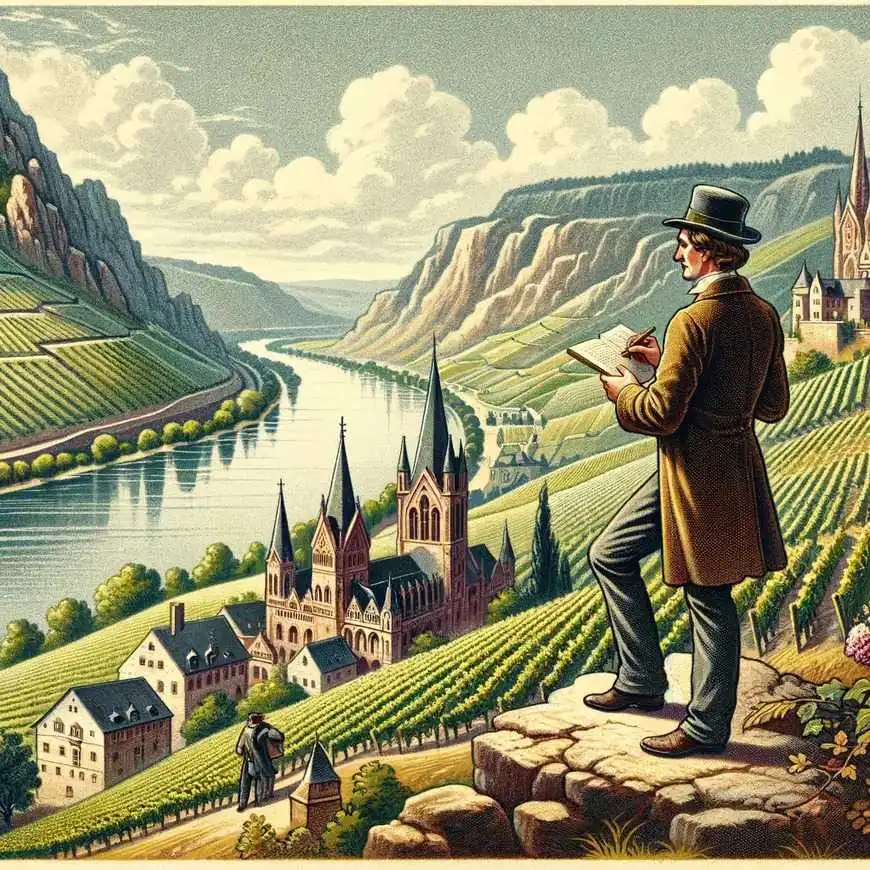A Vivid Journey Through Time and Space – “Travel Pictures” by Heinrich Heine
My Summary of Travel Pictures by Heinrich Heine
Reading “Travel Pictures” by Heinrich Heine was a delightful journey. The vivid descriptions and witty observations brought each place to life. Heine’s humor and keen insights made me feel like I was traveling alongside him.
Emotionally, the book was both amusing and reflective. I laughed at Heine’s sharp critiques of society and felt a sense of wonder at his love for nature. His ability to find beauty and absurdity in his travels resonated with me.
Intellectually, the book made me appreciate Heine’s sharp mind and poetic language. His reflections on culture, history, and politics were thought-provoking. The blend of travel narrative and personal commentary kept me engaged. This book deepened my understanding of the world through Heine’s eyes and left me eager to explore more of his work.
Heinrich Heine, the renowned German poet and writer, takes readers on a fascinating literary adventure with his collection of travel essays, “Reisebilder” (Travel Pictures). This captivating work, published between 1826 and 1831, is a tapestry of vivid descriptions, personal reflections, and insightful observations of the places and people he encounters during his journeys. With Heine as your guide, prepare to embark on a voyage that traverses time, space, and the depths of human emotions.
Introduction to “Travel Pictures”
“Travel Pictures” is a collection of four volumes of travel essays. These essays paint an evocative picture of the world through Heinrich Heine’s eyes. Heine was born in Düsseldorf, Germany, in 1797. He became an influential figure in the Romantic movement. He was known for his lyrical poetry and passionate prose. Throughout his life, Heine embarked on several journeys. “Travel Pictures” compiles his impressions and reflections. He writes about the places he visited, the people he encountered, and the historical events that shaped the world around him.

Volume I: The Harz Journey and Volume II: The North Sea
In the first volume of “Travel Pictures,” Heine takes readers on a journey to the Harz Mountains in Germany. Through his poetic and descriptive prose, he vividly captures the beauty of the landscapes, the charm of the quaint towns, and the allure of the folktales and legends that permeate the region. Heine’s writing effortlessly transports readers to the heart of the Harz, igniting a sense of wanderlust and an appreciation for the natural wonders of the world.
Heine’s second volume invites readers to explore the coastal regions of the North Sea. His eloquent descriptions of the sea’s vastness and power, the maritime culture, and the hardworking fishermen paint a poignant picture of life along the coastline. In this volume, Heine also delves into themes of nostalgia and longing, evoking emotions that resonate with readers from all walks of life.
Volume III: The Return Home and Volume IV: Italy
In the third installment of “Travel Pictures,” Heine reflects on his return to Germany. He had lived in Paris for several years. In this introspective volume, he explores the concept of “home.” He grapples with questions of identity and belonging. Heine’s musings on his roots and the changes he observes in his homeland offer readers a glimpse into his sensitive and introspective mind.
In the final volume, Heine takes readers on a journey to Italy. Italy is renowned for its art, history, and cultural richness. Through his essays on cities like Rome, Venice, and Naples, Heine captures the essence of Italy’s allure. He shows the profound impact it had on him as an artist. He intertwines personal experiences with historical anecdotes. This results in a multifaceted exploration of this captivating country.
Literary Style and Impact:
Heinrich Heine’s writing style blends romantic lyricism and keen observation. His vivid imagery and poetic language bring the places he visits to life. This allows readers to immerse themselves in the sights, sounds, and emotions of each destination. His introspective and philosophical musings add depth and complexity to the travel essays. This elevates “Travel Pictures” beyond a mere collection of travelogues.
The impact of “Travel Pictures” extends beyond its artistic and literary significance. Heine’s acute observations on social, political, and cultural landscapes offer valuable historical insights. Furthermore, his reflections on identity and belonging resonate with readers to this day. This makes the work relevant and relatable in a modern context.
Heinrich Heine’s “Travel Pictures” remains a timeless and enduring work of travel literature. His ability to bridge the gap between the personal and the universal, and the present and the past, makes “Travel Pictures” a literary gem. It continues to captivate and inspire readers worldwide.
The influence of Heine’s writing extends beyond travel literature. His poetry and prose have inspired countless writers, musicians, and artists. This leaves an indelible mark on the cultural landscape. Heine’s impact on German literature and the Romantic movement ensures that his legacy endures. Readers continue to be enchanted by his words and the enchanting journeys he shares in “Travel Pictures.”

Trivia from Travel Pictures
- Multifaceted Composition: “Travel Pictures” is not just a travelogue; it combines poetry, narrative, and essays. It ranges from lyrical descriptions of landscapes to satirical comments on society and culture.
- Innovative Literary Form: Heine’s “Travel Pictures” is considered innovative for its time due to its blend of prose and poetry, and its mix of personal reflection with cultural criticism. This approach influenced the development of the travel literature genre.
- Exile: Due to his political views and the controversial nature of his writings, including those in “Travel Pictures,” Heine spent the latter part of his life in exile in Paris. This experience of being an outsider influenced much of his later work.
- Influence on Future Writers: “Travel Pictures” and Heine’s other writings had a significant influence on both German literature and the broader European literary scene. Writers such as Nietzsche, Marx, and Freud admired and were influenced by Heine’s work.
- The Lorelei: One of Heine’s most famous poems, “Die Lorelei,” is included in “Travel Pictures.” This poem has become part of German folklore. It tells the tale of the Lorelei, a figure who sits on a cliff above the Rhine River and lures sailors to their doom.
- Critique of Romanticism: While part of the Romantic movement, Heine also critiqued some of its aspects. His work in “Travel Pictures” reflects a more nuanced view of Romanticism, often highlighting its limitations and contradictions.
Memorable Quotes from “Travel Pictures”
- “Where words leave off, music begins.” This quote highlights Heine’s belief in the transcendent power of music to express what words cannot. It suggests that music has the ability to convey emotions and ideas that are beyond the reach of language, touching on the ineffable aspects of human experience.
- “I fell asleep with the full moon, and she looked into my soul.” This evocative sentence reflects Heine’s romantic inclination, personifying the moon as a witness to his innermost thoughts and feelings. It suggests a connection between the individual and the natural world, a common theme in Romantic literature.
- “The sea is a desert of waves, a wilderness of water.” In this quote, Heine uses an oxymoron to describe the vastness and emptiness of the sea. By comparing it to a desert, he emphasizes its isolation and the unending expanse that separates lands and peoples. It reflects on the dual nature of the sea as both a barrier and a passage.
- “When the heroes go off the stage, the clowns come on.” This quote can be interpreted as a commentary on political and social shifts. It suggests that after the era of great leaders ends, it is followed by a period dominated by lesser figures. Heine often critiqued the political landscape of his time.
Bonus Fact: “Buch der Lieder” Connection! Heine’s “Travel Pictures” also contains verses from his earlier work, “Buch der Lieder” (Book of Songs). The seamless integration of poetic elements from his poetry collection into his travel essays showcases the his brilliance.
Legacy and Enduring Appeal
Heinrich Heine’s “Reisebilder” (Travel Pictures) continues to captivate readers. It has timeless charm and poetic eloquence. The book’s enduring appeal lies in its ability to transport readers to various destinations. These destinations are both geographical and emotional. Heine’s introspective reflections on identity, love, and the human experience resonate across cultures and generations. This makes “Travel Pictures” a work that stands the test of time.
Moreover, Heine’s pioneering approach to travel literature combines personal experiences with historical context. This combination paved the way for a more profound and artistic treatment of the genre. His influence can be seen in the works of travel writers and essayists who follow in his footsteps. They aim to capture not just the sights but also the essence of the places they explore.
Conclusion: Travel Pictures
In conclusion, “Travel Pictures” by Heinrich Heine is a captivating collection of travel essays. It takes readers on a mesmerizing journey through time and space. From the picturesque Harz Mountains to the captivating coastal regions of the North Sea, Heine’s poetic prose captures each destination’s essence with unparalleled eloquence. Additionally, the cultural richness of Italy comes alive in his writing.
Beyond its literary prowess, “Travel Pictures” offers readers a glimpse into the mind of a sensitive and insightful traveler. Heine’s musings on identity, belonging, and the human experience add depth to the travel essays. This makes the work an enduring and thought-provoking masterpiece.
If you seek a literary voyage that stirs the soul and ignites the imagination, “Reisebilder” (Travel Pictures) is a must-read. Connect with the profound wisdom of a celebrated poet. Embark on a journey that transcends the boundaries of time and space. Heinrich Heine’s “Travel Pictures” invites you to set sail on an unforgettable literary adventure.
More Reviews of Works by Heine
“The Book of Songs” by Heinrich Heine: A Melodic Journey Through Love, Longing, and Life My Summary of Book of…
A Winter’s Tale: Heinrich Heine’s Vision of Germany and the Human Condition Quick Summary: My Thoughts on A Winter’s Tale…

